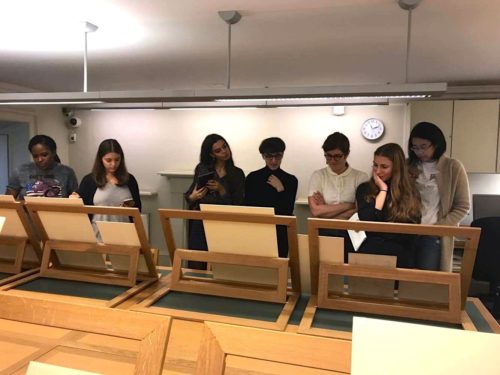Our Documenting Fashion MA class recently visited the Courtauld’s Prints and Drawings study room. Our class theme that day was ‘Modernity,’ and we were focusing on texts by Charles Baudelaire to explain the shift towards modernism, and how it impacted both art and the representation of dress. The Courtauld’s Prints and Drawings room houses approximately 7000 drawings and watercolours, and 26000 prints ranging from the Middle Ages up to the twentieth century. The prints, drawings and paintings we were studying on this visit were mostly from the late nineteenth century, around the same time that Baudelaire was writing about modernism.

It was interesting to view the shift in that period in respect to the representation of women, class and their dress, but most notably the techniques of depiction. Whereas earlier paintings which we viewed strived to be more realistic in both colour and shape, the later drawings seemed to be more relaxed, with free flowing lines and unaltered black ink. In ‘The Modern Public and Photography,’ Baudelaire discusses dreams and reality in relation to both photography and painting, and is against taking either at face value as real life: “The painter is becoming more and more inclined to paint, not what he dreams, but what he sees. And yet it is a happiness to dream, and it used to be an honour to express what one dreamed.” In the study room, a portrait of Lady Adelaide Stanhope by Alfred Edward Chalon was on display next to Paul Cézanne’s sketch of Hortense Fiquet. Completed circa 1880, Cézanne’s graphite drawing was done a few decades later than Chalon’s and it certainly shows a difference in their techniques. Lady Adelaide’s portrait is in colour and is extremely detailed – her hair and the textures of her dress are what some would call ‘realistic,’ whereas Madame Cézanne is compositionally incomplete, with many large blank spaces and ‘unfinished’ shading. In this example, it is the viewer who dreams and fills in the missing elements of the picture.

[Right} Madame Cézanne by Paul Cézanne, 1880.
Another example we viewed of these new techniques in depicting reality was Edouard Manet’s 1871 La queue devant La Boucherie. The etching effectively shows people queuing for food in Paris, whilst remaining open in shape and form. The umbrellas highlight the shapes in the image, whilst simultaneously forming the outline of the unified yet fleeting crowd. As Baudelaire notes about one of his subjects in ‘The Painter of Modern Life,’ “he is the painter of the passing moment and of all the suggestions of eternity that it contains.” For Baudelaire, modernity is ephemeral and contingent on the times. It is up to the painter, the drawer or the photographer to capture these moments, in order for us to observe them and their many differences, as we did in the Prints and Drawings study room.
By Grace Lee
To book a visit to the Courtauld Prints and Drawings study room, visit http://courtauld.ac.uk/gallery/collection/drawings-prints/prints-and-drawings-study-room
Bibliography
Baudelaire, Charles, The Painter of Modern Life and Other Essays, (London: Phaidon, 1964)
Baudelaire, Charles, ‘The Modern Public and Photography’, in Alan Trachtenberg, ed., Classis Essays on Photography, (New Haven: Leete’s Island Books, 1980), pp. 83-89


